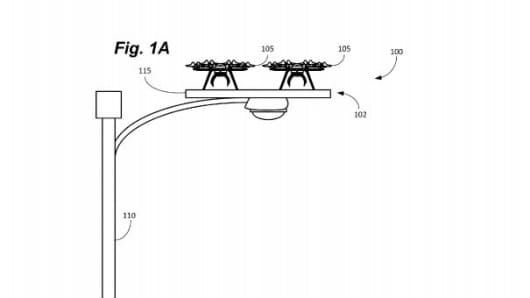Amazon has been awarded a patent for "docking stations" for its delivery drones that will be built on tall structures such as lampposts or churches and allow the unmanned machines to recharge and pick up packages.
"The docking stations may incorporate a number of features to enable UAVs (unmanned aerial vehicles) to fly longer routes, to fly routes more accurately, and to provide shelter during adverse conditions," Amazon's U.S. Patent and Trademark Office (USPTO) filing said.
Amazon is currently grappling with regulators on getting regulation passed that supports its plan to deliver parcels by unmanned flying machines. Toward the end of June, the Federal Aviation Administration (FAA) issued new rules that essentially killed off Amazon's drone plans.
Still, the U.S. e-commerce giant has been filing patents and testing out its drones.
The latest patent describes docking stations which could be installed on cell towers, church steeples, office building, electric poles, and generally tall structures. It would allow a drone to land, avoid bad weather, recharge or refuel and drop off and pick up packages.
Amazon outlines the idea of a "central control system" which could communicate with each docking station. The system would calculate the most direct route for a drone to follow, and be able to redirect it along a path with the most favorable conditions, for example, with the least wind.
The ability to recharge is also very useful as the drones are unlikely to be able to travel very large distances.
A drone could also transfer packages at these docking stations. Once it lands, it could deliver a package on a platform which would then move it down via a "vacuum tube, dumbwaiter, elevator, or conveyor" to a delivery person on the ground.
Amazon also said the docking stations could act as cell towers, so that they could provide local free or fee-based internet services in public areas "without bearing the burden of installing some, or all, of the necessary infrastructure".
Also, the docking stations could be used for advertising to "generate additional revenue for the provider", according to Amazon.
The patent follows one awarded to Amazon last year which outlined how the drones would "talk" to each other to plan routes and communicate.
Like with all patents, the idea may never come to fruition.
Amazon is currently grappling with regulators on getting regulation passed that supports its plan to deliver parcels by unmanned flying machines. Toward the end of June, the Federal Aviation Administration (FAA) issued new rules that essentially killed off Amazon's drone plans.
Still, the U.S. e-commerce giant has been filing patents and testing out its drones.
The latest patent describes docking stations which could be installed on cell towers, church steeples, office building, electric poles, and generally tall structures. It would allow a drone to land, avoid bad weather, recharge or refuel and drop off and pick up packages.
Amazon outlines the idea of a "central control system" which could communicate with each docking station. The system would calculate the most direct route for a drone to follow, and be able to redirect it along a path with the most favorable conditions, for example, with the least wind.
The ability to recharge is also very useful as the drones are unlikely to be able to travel very large distances.
A drone could also transfer packages at these docking stations. Once it lands, it could deliver a package on a platform which would then move it down via a "vacuum tube, dumbwaiter, elevator, or conveyor" to a delivery person on the ground.
Amazon also said the docking stations could act as cell towers, so that they could provide local free or fee-based internet services in public areas "without bearing the burden of installing some, or all, of the necessary infrastructure".
Also, the docking stations could be used for advertising to "generate additional revenue for the provider", according to Amazon.
The patent follows one awarded to Amazon last year which outlined how the drones would "talk" to each other to plan routes and communicate.
Like with all patents, the idea may never come to fruition.



No comments:
Post a Comment